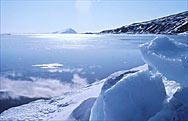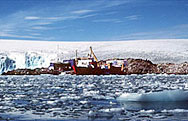When we leave UAB we will drive to the Birmingham Airport. Although we have had most of our scientific equipment shipped down to Antarctica already we will still be loaded down with a number of things, such as our diving gear that we needed here for training, as well as other things that we need so desperately for our work that we wanted to carry them ourselves. So, most of us will have two or three "excess" bags in addition to our two personal bags of clothing and other things. With four of us total, it will be a big load.
First we fly to Atlanta, where we will rendezvous with Bill Baker and Bruce Furrow from Florida Tech. From there we fly to Miami where we meet up with Joanna Hubbard, the middle school science teacher from Alaska who will be working with us. At that point the group is complete and will travel together.
The longest leg of our flights down is next: eight and a half hours to Santiago, the capital city of Chile. There we will be met by agents contracted by the National Science Foundation (NSF) who will help us collect our bags and get to our next flight. That will take us to the Chilean port city of Punta Arenas on the Straights of Magellan. There we will be met by another agent who will take us to our hotel for a much needed and hopefully long night's sleep. If all goes well, when we get to Punta Arenas it will have been about 24 hours since we got on the plane in Birmingham.
Southern Chile is a wonderful area of the world, and so we are going to be taking advantage of that with two days of vacation. The day after we arrive in Punta Arenas we will rent a minivan and drive about six hours to a spectacular national park called Torres del Paine. Then, back to Punta Arenas, where we will spend a day getting our special Antarctic clothing from the NSF contractor and loading ourselves and our gear on board theR/V Laurence M. Gould. That is the NSF's research ship that will take us to Palmer.
It will be a three-to-four day cruise from Punta Arenas across the Drake Passage before we get to the station. Although it can be quite flat and calm, the Drake Passage does have the reputation of being the roughest part of the world's oceans. On my very first crossing to Palmer in 1985, we had 50 foot seas much of the way. So, it could be a "fun" trip.
Although we probably will not be able to receive messages until we get to Palmer Station we hope to be able to send messages from the ship. On our first opportunity we will let you know how the journey is going.


